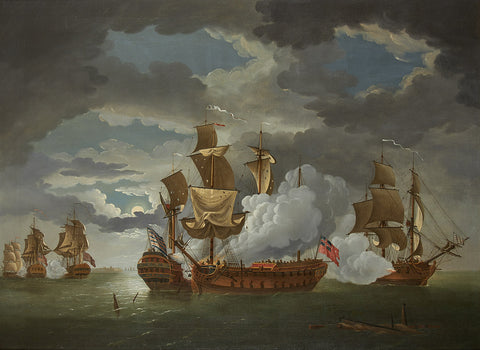Emerald Warriors: The Story of the Irish Marines Who Fought for American Independence

“John Adams reviews Jones' Irish Marines, 13 May 1779” by Charles H. Waterhouse.
The American Revolutionary War wasn't just fought by colonists. A surprising number of foreign volunteers joined the fight for independence, including a contingent of Irish Marines. Often overshadowed in history, they played a crucial role in John Paul Jones’s naval force as he hunted British Ships off the coast of Western Europe.
The Irish Marines were known as the Corps des Volontaires Irlandais (Hibernian Marine Corps) or Les Marines Irlandais. These men weren’t Irish by birth, but by heritage. Penal Laws in Ireland discriminated against Catholics, forcing many to enlist in foreign armies, particularly the French. So, when France secretly aided the American cause, Irish soldiers found themselves fighting for a new republic across the Atlantic.
Amidst the backdrop of escalating tensions between Britain and the newly independent United States, John Paul Jones, a renowned naval commander, arrived in France in 1778 seeking aid for the fledging American Navy, which included a warship.
France, wary of directly confronting Britain, provided Jones with the Bonhomme Richard, a merchant ship converted for war. Originally called Duc de Duras, Jones renamed the ship Bonhomme Richard in honor of Benjamin Franklin, who published Poor Richard’s Almanack in France under the title Les Maximes du Bonhomme Richard
The crew of the Bonhomme Richard, however, was a mixed bag, lacking experience and discipline. Jones, noticing the quality of the Irish Marines stationed in France, requested their inclusion in his crew.
Recognizing the opportunity to strike a blow against British tyranny, these Irish Marines, around 140 by some historical estimates, gladly offered their service to Jones. These seasoned fighters, skilled in musketry and hand-to-hand combat, were a valuable addition. Clad in distinctive red uniforms, they stood out amidst the motley crew.
In May 1779, while Jones was docked in L’Orient, John Adams, who was serving as American Commissioner to France at the time, came to visit Jones. Jones hosted a dinner for Adams, showcasing the Bonhomme Richard and the Irish Marines. Adams, impressed by their discipline and fighting spirit, inspected them alongside Jones (pictured above), recognizing their indispensable role in the struggle for American independence.
Throughout Jones's daring sea battles against the British, the Irish Marines proved their mettle time and again. The most significant battle was the Battle of Flamborough Head on September 23, 1779, an epic clash between Jones and British warships.
In a brutal display of firepower, the Bonhomme Richard locked horns with the British HMS Serapis. Despite being outnumbered and outgunned, John Paul Jones's daring tactics and the ferocious fighting spirit of his crew, including the Irish Marines, turned the tide of the battle.
For nearly four hours, the Bonhomme Richard and the Serapis pounded each other with relentless cannon fire, inflicting heavy damage on both vessels. In a crucial maneuver, the American crew, aided by the fierce fighting of the Irish Marines, managed to grapple the Serapis – essentially tying the ships together. This allowed the Bonhomme Richard to continue inflicting damage to the Serapis.
At the same time, the Bonhomme Richard crew prevented the British from attempting to board the Bonhomme Richard, a move that could have easily forced Jones's surrender.
The battle raged on, but the tide began to shift decisively in the Americans' favor. With the arrival of another American warship, the Alliance, the pressure on the Serapis intensified. Eventually, overwhelmed and heavily damaged, the British captain was forced to surrender to Jones.

“Action Between the Serapis and Bonhomme Richard” by Richard Paton in 1780.
Though the Bonhomme Richard itself was so badly damaged it began to sink, Jones managed to transfer his crew to the captured Serapis. The crew was able to sail the captured British ship to Holland for repairs.
The Battle of Flamborough Head became one of the most celebrated naval battles of the American Revolution, and the American victory was one of the factors that helped France decide to aid America in the fight against the British. Fighting with unparalleled bravery, the Marines played a key role in securing the victory for the Americans.
The impact of the Irish Marines attached to Jones cannot be overstated. Their unwavering resolve and commitment exemplified the spirit of freedom that defined the era. The legacy of these often-forgotten warriors, just like the countless Irish immigrants who helped fight against the British in America, is a testament to the bond between Ireland and America in a shared pursuit of freedom.
